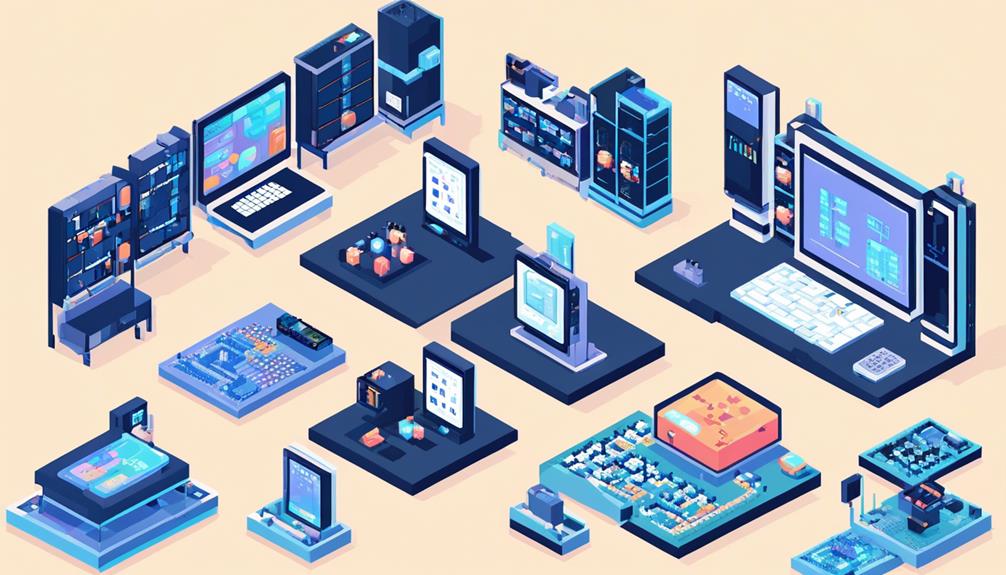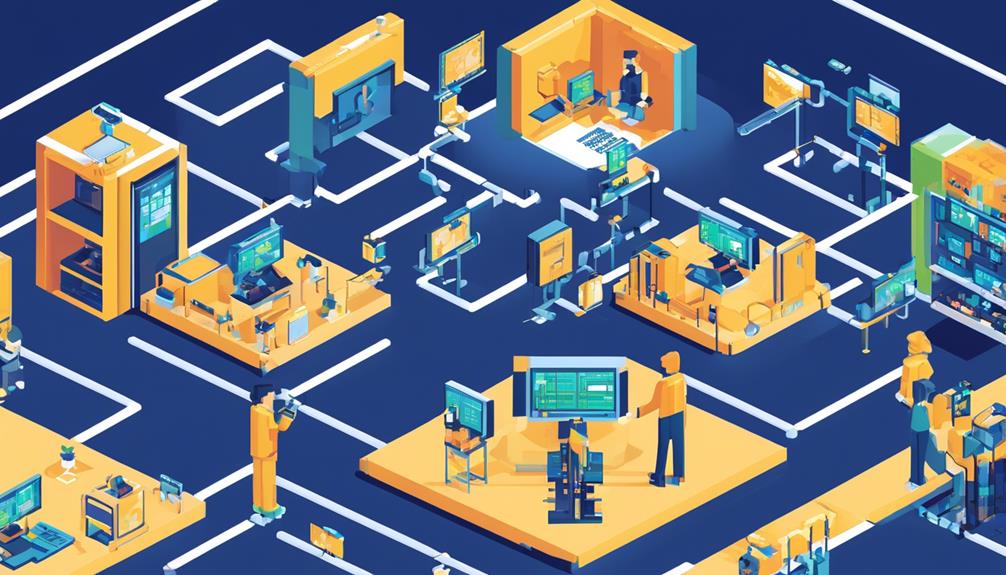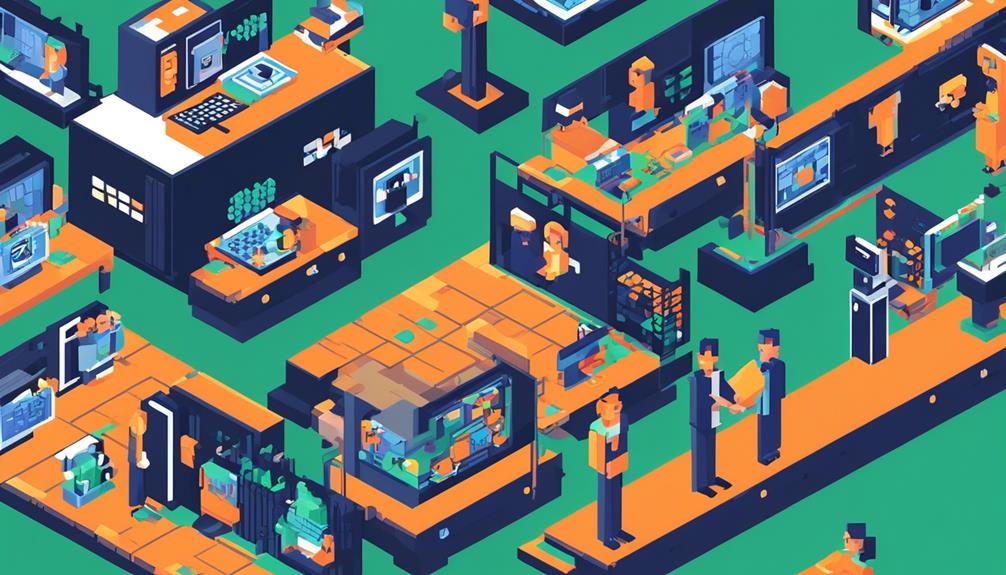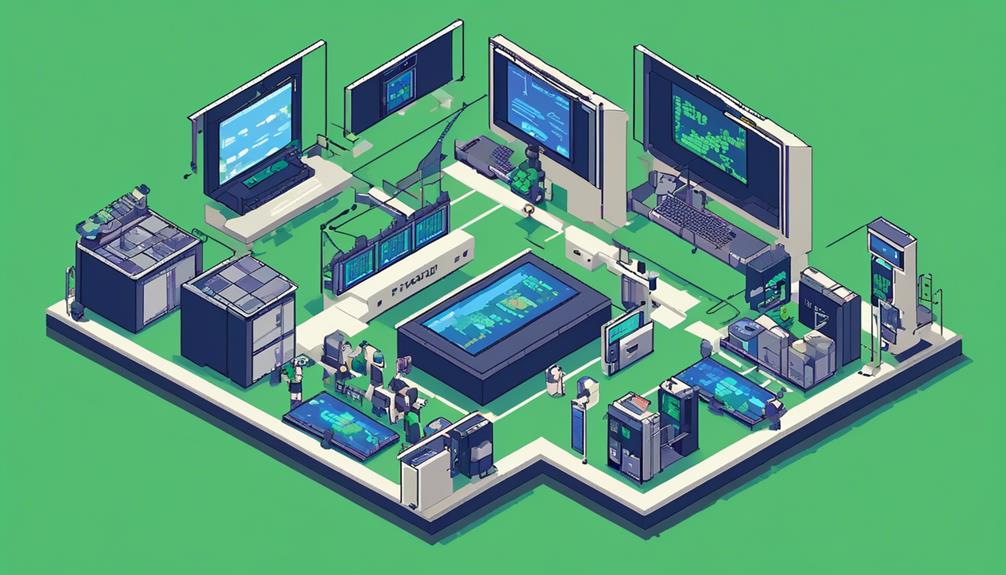In today's data-driven world, edge computing hardware for video analytics is gaining increasing importance.
With the proliferation of AI systems and the exponential growth of data generated for analysis, traditional cloud data centers can introduce latency issues that hinder real-time analysis.
However, edge computing devices offer a solution by bringing data storage and processing closer to where the data is generated, eliminating latency and bandwidth problems.
This enables faster insights, real-time decision-making, and improved customer satisfaction.
In this discussion, we will delve into the importance of hardware in edge computing, the benefits it provides for real-time video analytics, and the significance of leveraging edge devices for faster insights in the context of video analytics.
Key Takeaways
- Edge computing hardware plays a significant role in enabling real-time video analytics by bringing data storage and processing closer to the original sources.
- Edge computing devices eliminate latency and bandwidth problems, providing faster insights and real-time decision-making capabilities.
- AI-driven edge devices equipped with optimized hardware are effective in analyzing video streams and enhancing security measures.
- Edge computing is suitable for applications that require immediate processing and response, making it ideal for video analytics use cases such as autonomous vehicles, surveillance systems, retail analytics, and inventory management.
Edge Computing Basics

Edge computing is a distributed IT architecture that strategically processes client data near its original sources, significantly reducing latency and minimizing reliance on centralized data centers. This approach brings data storage and processing closer to where data is generated, enabling real-time business insights and actionable results. By eliminating latency and bandwidth problems, edge computing devices offer faster insights on the spot.
When it comes to video analytics, edge computing provides low latency and eliminates the need for high bandwidth, making it an ideal solution. Traditional video analytics systems rely on sending large amounts of data to centralized data centers for processing, which can result in significant delays. However, with edge computing, the processing is done right at the edge of the network, near the video sources themselves. This allows for real-time analysis and immediate action, without the need for data to travel back and forth to a centralized location.
The basics of edge computing hardware for video analytics involve deploying edge devices at the edge of the network. These devices are specifically designed to handle the processing and storage requirements of video analytics applications. They are equipped with powerful processors, sufficient memory, and high-capacity storage to handle the demands of real-time video processing. Additionally, edge computing hardware for video analytics often includes specialized hardware accelerators, such as GPUs or FPGAs, to enhance the performance and efficiency of video processing tasks.
Importance of Hardware in Edge Computing
With the increasing demand for real-time data processing and the need to address latency and bandwidth issues, the role of hardware in edge computing becomes paramount. Edge computing, which brings data storage and processing closer to the data source, is particularly crucial for applications like video analytics. In this context, hardware plays a significant role in enabling edge-based video analytics and efficient data processing.
When it comes to video analytics, the importance of hardware in edge computing cannot be overstated. Edge computing hardware allows for faster insights and real-time decision-making by reducing the latency associated with sending video data to remote servers for processing. By bringing the processing power closer to the edge, edge computing hardware enables real-time analysis of video streams, facilitating applications such as smart surveillance, facial recognition, and object detection.
AI-driven edge devices equipped with optimized hardware are especially effective in video analytics. These devices leverage specialized chips, such as graphic processing units (GPUs) and tensor processing units (TPUs), to accelerate the processing of video data. By offloading the computational workload to dedicated hardware, these devices can provide low latency and eliminate the need for high bandwidth, making them ideal for edge-based video analytics in scenarios where network connectivity may be limited or unreliable.
Furthermore, the importance of hardware in edge computing extends beyond video analytics. The unprecedented growth in data touch points and the challenges of big data make edge computing hardware crucial for efficient data processing. By processing data near the source, edge computing hardware reduces the need for transmitting large volumes of data to centralized servers, saving bandwidth and reducing network congestion.
Real-Time Video Analytics Benefits

Real-time video analytics offers numerous benefits, including improved security measures, automated processing, and enhanced search and monitoring capabilities. By employing edge computing devices and AI technology, real-time video analytics enables organizations to extract valuable insights from video data in a timely manner.
One of the key advantages of real-time video analytics is its ability to enhance security measures. Traditional video surveillance systems often rely on manual monitoring, which can be labor-intensive and prone to human error. With real-time video analytics, AI algorithms can analyze video feeds in real-time, automatically detecting and alerting security personnel to potential threats or anomalies. This proactive approach allows for quicker response times and more effective incident management.
Additionally, real-time video analytics enables automated processing of video data. AI algorithms can be trained to automatically identify and classify objects, people, and events in video streams. This automation eliminates the need for manual review and analysis, saving time and resources. Furthermore, real-time video analytics can integrate with other systems, such as access control or alarm systems, enabling automated actions based on detected events, such as locking doors or sounding alarms.
Furthermore, real-time video analytics provides enhanced search and monitoring capabilities. With AI-powered video analytics, organizations can quickly search through vast amounts of video footage to find specific events or objects of interest. This enables faster investigations and improves situational awareness. Moreover, real-time monitoring capabilities allow for immediate response to emerging situations, ensuring a proactive approach to security and safety.
Edge Computing Vs Cloud Computing
When comparing edge computing and cloud computing, it is important to consider their respective pros and cons, as well as their performance and scalability.
Edge computing excels in providing real-time insights and reducing latency, making it ideal for applications that require immediate processing and response.
On the other hand, cloud computing offers centralized data storage and processing, enabling scalability and the ability to handle large amounts of data.
Edge Vs Cloud
Edge computing and cloud computing are two distinct approaches to data storage and processing, each with its own advantages and considerations.
Edge computing brings data storage and processing closer to where data is generated, reducing the need for centralized data centers. This approach offers low latency and eliminates potential latency issues that can arise with cloud computing.
For video analytics, edge systems driven by AI-enabled devices provide faster insights on the spot, reducing maintenance calls and increasing customer satisfaction. Edge computing is particularly beneficial for real-time analysis and mission-critical information delivery.
On the other hand, cloud computing relies on sending data to centralized data centers for processing, which can result in latency issues. While cloud computing offers scalability and cost-effectiveness, it may not be suitable for applications that require low latency and real-time processing, making edge computing a preferred choice for video analytics and AI applications.
Pros and Cons
With the advantages and considerations of edge computing and cloud computing in mind, it is important to evaluate the pros and cons of each approach when it comes to data storage and processing.
Edge computing brings data storage and processing closer to where data is generated, reducing latency and bandwidth issues. Employing edge computing can eliminate latency problems, ensuring real-time, mission-critical information delivery. It provides low latency and eliminates the need for high bandwidth, making it suitable for AI systems analyzing photos and videos. Security concerns regarding data transfer and Internet connection can also be addressed with edge computing.
However, relying solely on cloud data centers can cause latency issues, slowing down the delivery of real-time, mission-critical information. Cloud computing may also lead to increased internet bandwidth and costs as more data is pushed to the cloud or data center.
While edge computing requires deploying and managing computing resources at multiple edge locations, which can be complex and costly, it is preferred for applications with low latency requirements.
Performance and Scalability
Performance and scalability are crucial factors to consider when comparing edge computing and cloud computing for video analytics.
Edge computing offers lower latency and faster processing, making it an ideal solution for real-time, mission-critical video analytics applications. The proximity of data processing to the point of data generation enhances the performance of edge computing, eliminating latency and bandwidth problems that may be encountered in cloud computing.
Scalability in edge computing allows for efficient processing of increasing data volumes close to the source, ensuring that video analytics can be performed in a timely manner. This is particularly important in scenarios where high bandwidth is not readily available or when processing large amounts of data in real-time.
Therefore, the hardware used in edge computing plays a vital role in ensuring optimal performance and scalability for video analytics applications.
Security Considerations in Edge Computing
When deploying edge computing for video analytics, it is crucial to consider the security implications.
Data privacy concerns arise due to the proximity of data storage and processing to the edge devices, making it necessary to implement robust security measures.
Network security becomes paramount in protecting the communication between edge devices and the central infrastructure, requiring the use of encryption, authentication, and access control mechanisms to mitigate potential vulnerabilities.
Data Privacy Concerns
Data privacy concerns in edge computing necessitate robust security considerations to ensure the protection of sensitive data. With the use of edge computing hardware and video analytics, data is processed and analyzed locally on edge devices, reducing the need for data transfer and minimizing the risk of data breaches.
Here are four key security considerations for addressing data privacy concerns in edge computing:
- Secure data transmission: Implement encryption protocols to safeguard data during transmission between edge devices and central servers.
- Access control: Employ strict access control mechanisms to ensure that only authorized personnel can access and manipulate sensitive data.
- Anonymization techniques: Use AI technology to anonymize data, removing personally identifiable information to protect individual privacy.
- Physical security: Ensure the physical security of edge devices, such as surveillance cameras, to prevent unauthorized access and tampering.
Network Security Measures
To ensure comprehensive data privacy and protection in edge computing, robust network security measures are crucial.
Edge computing, particularly in the context of video analytics and data-intensive applications like surveillance, requires a secure network infrastructure to safeguard sensitive information. Implementing network segmentation is essential to isolate different parts of the edge network and control traffic flow.
Firewalls and intrusion prevention systems should be employed at the edge to filter and monitor network traffic, protecting against potential threats. Additionally, encrypted communication channels and secure protocols should be used to ensure data integrity and confidentiality during transit.
Strong authentication mechanisms and access controls must be implemented to prevent unauthorized access to edge devices and systems. Regularly updating and patching edge devices and systems is also necessary to address known vulnerabilities and maintain a secure computing environment.
Edge Computing for Autonomous Vehicles

Edge computing for autonomous vehicles revolutionizes data processing by enabling real-time decision-making capabilities and reducing latency through AI-driven edge devices. This technology brings numerous benefits to the autonomous vehicle industry, enhancing safety, efficiency, and overall performance.
Here are four key ways that edge computing is transforming autonomous vehicles:
- Reduced Latency: Edge computing brings data processing closer to the source, enabling quicker response times. By analyzing and processing data locally on edge devices, autonomous vehicles can make faster decisions without relying on a remote server. This significantly reduces latency and ensures real-time responsiveness, critical for safe and efficient autonomous driving.
- Improved Security: Edge computing eliminates the need for high bandwidth and constant internet connection in autonomous vehicles. By processing data locally, it addresses security concerns regarding data transfer and potential vulnerabilities associated with relying on cloud-based solutions. This ensures that sensitive information remains within the vehicle, enhancing data privacy and protection.
- Enhanced Decision-Making: AI-driven edge devices offer faster insights on the spot. By leveraging machine learning algorithms, these devices can analyze vast amounts of data in real-time, enabling autonomous vehicles to make intelligent decisions based on the immediate environment. This enhances the vehicle's ability to adapt to changing road conditions, improving safety and efficiency.
- Reduced Maintenance Calls: Edge computing significantly reduces the need for constant communication with a remote server, resulting in fewer maintenance calls. By processing data locally, autonomous vehicles can operate more independently, minimizing the reliance on external infrastructure. This improves customer satisfaction and reduces operational costs.
Edge Computing for Surveillance and Security
The implementation of edge computing technology significantly enhances surveillance and security systems by bringing data storage and processing closer to the source, allowing for real-time analysis and low latency. Edge computing for video analytics is particularly beneficial in these domains as it enables the processing of data-intensive applications, such as real-time tracking and face recognition systems, directly at the edge devices, such as surveillance cameras.
By leveraging edge computing, surveillance and security systems can overcome the limitations of traditional cloud-based architectures. Edge computing brings data processing capabilities closer to the cameras, reducing the latency between data capture and analysis. This low latency is crucial in security scenarios where real-time analysis is necessary for immediate threat detection and response.
Moreover, edge computing eliminates the need for high bandwidth connections and reduces the reliance on constant internet connectivity. This addresses security concerns regarding data transfer and potential vulnerabilities associated with relying on a centralized cloud infrastructure. Data can be processed and analyzed locally, minimizing the risk of data breaches and ensuring the privacy and security of sensitive information.
In addition, edge computing enables the integration of Internet of Things (IoT) devices into surveillance and security systems, creating a comprehensive and interconnected network. IoT devices, such as sensors and smart cameras, can gather valuable data that can be processed and analyzed at the edge, facilitating real-time decision-making and enhancing situational awareness.
Real-Time Store Foot Traffic Tracking
Real-time store foot traffic tracking is a crucial aspect of optimizing store operations.
By utilizing edge computing, businesses can analyze foot traffic patterns in real-time, allowing for immediate insights and actionable decisions.
This technology enables businesses to efficiently monitor foot traffic, leading to improved product placement, staff allocation, and overall customer experience.
Foot Traffic Analysis
Foot traffic analysis, a key component of real-time store foot traffic tracking, utilizes cutting-edge technology to process and analyze data on customer movement within a retail environment. By leveraging edge computing for video surveillance and AI systems, businesses can gain valuable insights in real time.
Here are four important aspects of foot traffic analysis:
- Immediate insights: Real-time foot traffic analysis provides businesses with immediate insights into customer behavior, enabling them to optimize product placement and staff levels. This helps improve customer satisfaction and maximize sales opportunities.
- Stockout detection: By automatically recognizing spatial and temporal events within the store, foot traffic analysis can detect stockouts in real time. This prevents lost sales by notifying store staff promptly, ensuring that products are always available to customers.
- Enhanced security: Edge computing for foot traffic analysis enhances security measures by automating the processing of video surveillance data. This enables dynamic situational monitoring and helps identify and address potential security threats more efficiently.
- IoT integration: Foot traffic analysis can be seamlessly integrated with other Internet of Things (IoT) devices and systems, allowing businesses to gather comprehensive data for better decision-making. This integration enables a holistic approach to store management, optimizing operations and enhancing the overall customer experience.
Real-Time Tracking
Real-Time Store Foot Traffic Tracking technology provides immediate insights into customer behavior and enables businesses to optimize product placement and staff levels. By leveraging high-definition cameras and edge video analytics, this technology offers real-time data on customer movements and interactions within a retail space. This real-time business intelligence allows retailers to make quick, informed decisions, such as adjusting store layouts, optimizing service levels, and improving customer satisfaction. Through traffic monitoring and dynamic situational analysis, real-time tracking systems can also prevent lost sales by promptly identifying and notifying stockouts. To illustrate the impact of real-time tracking, consider the following table:
| Benefits of Real-Time Tracking |
|---|
| Immediate insights into customer behavior |
| Optimization of product placement and staff levels |
| Enhanced customer satisfaction through reduced waiting times and optimized service levels |
Preventing Lost Sales With Edge Computing
Edge computing offers a solution to prevent lost sales through its ability to enable real-time detection and notification of stockouts in stores. By leveraging edge computing for video analytics, retailers can effectively monitor their inventory levels and take immediate action when products run out of stock. Here's how edge computing helps prevent lost sales:
- Real-time monitoring:
Edge computing allows for traffic monitoring and dynamic data touch points, enabling retailers to track inventory levels in real-time. This ensures that they are aware of stockouts as soon as they occur, allowing them to take immediate action to restock and prevent lost sales.
- Edge AI and computer vision:
With edge AI and computer vision technologies, edge computing can analyze video feeds from in-store cameras to accurately detect stockouts. This enables retailers to automate the process of stock monitoring and receive instant notifications when items are running low, reducing the risk of lost sales due to unavailability of products.
- Faster decision-making:
By bringing data storage and processing closer to the source, edge computing provides faster insights and real-time decision-making capabilities. This allows retailers to respond promptly to stockouts and replenish inventory before potential customers leave empty-handed, preventing lost sales.
- Optimized storage infrastructure and capacity:
Edge computing optimizes storage infrastructure and capacity by storing and processing data locally. This reduces the reliance on centralized cloud systems and minimizes latency, ensuring that the detection and notification of stockouts are efficient and timely.
Workplace Face Recognition With Edge Computing

Workplace face recognition systems can be significantly enhanced through the implementation of edge computing technology. By leveraging edge computing for facial recognition, businesses can achieve efficient attendance tracking and enhance security measures. Edge computing enables real-time processing of facial recognition data at the workplace, minimizing latency and ensuring quick insights.
One of the key advantages of workplace face recognition with edge computing is the reduction in reliance on the internet and cloud data centers. This addresses security concerns by reducing the need for high bandwidth and potential vulnerabilities associated with transmitting sensitive data over the internet. The following table illustrates the benefits of workplace face recognition with edge computing:
| Benefits | Description |
|---|---|
| Improved Accuracy | Edge computing allows for real-time analysis of facial recognition data, resulting in improved accuracy for attendance and security systems. |
| Faster Response Times | With edge computing, facial recognition data can be processed locally, leading to faster response times for attendance and security applications. |
| Reduced Maintenance Calls | Edge computing reduces the need for frequent maintenance calls by processing data locally, increasing operational efficiency. |
| Enhanced Security | By minimizing reliance on the internet and cloud data centers, edge computing addresses security concerns associated with facial recognition systems. |
| Increased Operational Efficiency | Edge computing improves the efficiency of workplace face recognition systems, enabling seamless tracking of attendance and enhancing security measures. |
Through the integration of edge computing, workplace face recognition systems can achieve higher accuracy, faster response times, and increased operational efficiency. By reducing reliance on the internet and cloud data centers, edge computing also enhances the security of these systems. Overall, the implementation of edge computing technology in workplace face recognition systems offers numerous benefits, making it a valuable solution for businesses.
Edge Computing Use Cases in Video Analytics
The integration of edge computing technology in video analytics presents a multitude of use cases that enhance efficiency, address security concerns, and enable real-time analysis of data. By leveraging edge computing hardware, video analytics can be performed at the edge of the network, closer to where data is generated, eliminating the need for high bandwidth and reducing latency. This opens up various opportunities for organizations to leverage video analytics in a wide range of applications:
- Autonomous Vehicles: Edge computing enables real-time analysis of video data from cameras mounted on vehicles, allowing for improved object detection, lane monitoring, and collision avoidance. This enhances the safety and efficiency of autonomous vehicles.
- Surveillance and Security Systems: By deploying edge computing devices equipped with AI-enabled drives, video analytics can be performed locally, enabling real-time monitoring of surveillance footage. This helps in detecting and alerting security personnel to potential security threats promptly.
- Retail Analytics: Edge computing combined with IoT sensors can provide real-time tracking of store foot traffic. This data can be analyzed to optimize store layout, improve customer experience, and detect potential shoplifting incidents.
- Inventory Management: Edge computing can prevent lost sales by detecting stockouts in real-time. By analyzing video feeds from cameras installed in warehouses or retail shelves, organizations can automatically monitor inventory levels and trigger replenishment processes when necessary.
Leveraging Edge Devices for Faster Insights

Leveraging edge devices allows for accelerated insights through real-time data processing at the source, enhancing the efficiency and effectiveness of video analytics. This is particularly beneficial for data-intensive applications that require immediate analysis and response. Edge computing hardware enables video analytics applications to be performed locally, reducing the latency associated with transferring data to a central server for processing. By processing data at the edge, edge devices can provide faster insights and enable real-time decision making.
One of the main advantages of leveraging edge devices for video analytics is the improved monitoring capabilities. Edge devices equipped with AI-enabled drives can analyze video data on-site, allowing for real-time monitoring and analysis. This enhances security measures and critical use cases where immediate action needs to be taken.
Additionally, edge computing for video analytics eliminates the need for high bandwidth, as data is processed locally. This not only saves on bandwidth costs but also reduces the dependency on a stable network connection. The low latency provided by edge computing ensures that insights are generated quickly, enabling faster response times.
To better understand the benefits of leveraging edge devices for video analytics, consider the table below:
| Benefits of Leveraging Edge Devices for Video Analytics |
|---|
| Accelerated insights through real-time data processing |
| Improved monitoring capabilities |
| Enhanced security measures and critical use cases |
| Reduced dependency on high bandwidth and stable network connection |
What Is Edge AI Video Analytics?
Edge AI video analytics is a cutting-edge technology that involves processing and analyzing video data at the network's edge, enabling real-time decision-making and enhancing security measures. By leveraging the power of artificial intelligence (AI), organizations can harness the potential of video analytics to transform different aspects of their operations.
Here are four key implications of edge AI video analytics:
- Reduced latency and bandwidth issues: Edge AI video analytics processes and analyzes video data closer to its source, minimizing the need for data to travel long distances to cloud data centers. This reduces latency and bandwidth issues, allowing for quicker insights on-site without the need for high bandwidth.
- Real-time decision-making: The combination of edge AI and video analytics creates a localized source of intelligent video analytics at the network's edge. This enables real-time decision-making by providing quick insights and analysis on-site, without relying on cloud resources. This is particularly important in time-sensitive scenarios where immediate action is required.
- Enhanced security measures: Edge AI video analytics enhances security measures by automating the processing and analytics of video data. It enables real-time monitoring, alerts, and notifications, allowing organizations to proactively detect and respond to security threats. This is crucial for applications such as surveillance, access control, and perimeter protection.
- Improved search and monitoring capabilities: Edge AI video analytics improves search and monitoring capabilities by automatically extracting meaningful information from video data. It can detect specific objects, behaviors, or events, enabling efficient search and analysis of recorded video footage. This saves time and resources compared to manual review of large amounts of video data.
Significance of Edge AI in Video Analytics

The significance of Edge AI in video analytics lies in its ability to provide enhanced real-time analysis, improved data privacy, and reduced network latency.
By processing data at the edge of the network, Edge AI enables faster and more efficient decision-making, allowing for immediate response to events and minimizing the impact of latency.
Additionally, Edge AI enhances data privacy by keeping sensitive information localized and reducing the need for data transmission.
This combination of real-time analysis, improved privacy, and reduced latency makes Edge AI a critical component in video analytics systems.
Enhanced Real-Time Analysis
Enhanced real-time analysis in video analytics is crucial for leveraging the significance of Edge AI technology. By incorporating Edge AI into video analytics platforms, businesses can benefit from improved efficiency, security, and decision-making capabilities.
Here are four key reasons why enhanced real-time analysis is essential:
- Faster insights: Edge AI enables real-time decision-making by providing quicker insights on-site, reducing the need for data transfer and reliance on high bandwidth.
- Enhanced security: By processing and analyzing video data at the edge, Edge AI minimizes security concerns related to data transfer and Internet connection, ensuring better privacy and protection.
- Improved automation: Edge AI combined with video analytics automates processing and analytics, enhancing security measures, search capabilities, and monitoring efficiency.
- Diverse applications: Edge AI technology facilitates intelligent video analytics across various use cases, including workplace safety, traffic monitoring, and smart surveillance systems, enabling businesses to leverage the benefits of real-time analysis.
Improved Data Privacy
Improved data privacy is a significant advantage of integrating Edge AI technology into video analytics platforms. By leveraging edge computing hardware, video analytics can be performed closer to the source of the data, reducing the need for data transfer over public networks. This localized processing minimizes the reliance on cloud data centers, addressing potential privacy concerns associated with centralized data processing.
Moreover, edge AI for video analytics reduces the risk of data interception during transfer, ensuring the protection of sensitive information and enhancing privacy measures. By processing and storing sensitive data within the local environment, edge AI enhances privacy control and reduces the risk of unauthorized access.
This is particularly important for security applications and data compliance, as edge computing offers a more secure and private approach to video analytics.
Reduced Network Latency
By leveraging edge computing hardware to perform video analytics closer to the data source, reduced network latency becomes a significant advantage of integrating Edge AI technology into video analytics platforms. This reduction in network latency enables real-time decision-making and faster on-site insights, improving response times for data-intensive applications.
Here are four key reasons why reduced network latency is crucial in video analytics:
- Real-time monitoring and dynamic situational awareness: Edge AI allows for the immediate processing of video data, enabling real-time monitoring and quick response to events or anomalies.
- Efficient use of infrastructure and capacity: By processing video analytics at the edge, less bandwidth is required for transferring data to the cloud, optimizing the use of network resources.
- Enhanced security measures: With reduced network latency, security measures can be implemented and enforced in real-time, ensuring timely threat detection and response.
- Improved critical use cases: Edge AI in video analytics enables faster identification of critical events, such as security breaches or accidents, allowing for immediate action to be taken.
Use of Edge AI in Surveillance Systems

Edge AI technology revolutionizes surveillance systems by enabling real-time decision-making and localized intelligent video analytics at the network's edge. With the massive amount of data generated by surveillance systems, edge computing plays a crucial role in processing and analyzing this data in real-time. By bringing AI algorithms closer to the source of data generation, edge AI significantly reduces bandwidth usage and minimizes data access delays.
Surveillance systems traditionally relied on centralized processing, where video data was transmitted to a remote server for analysis. This approach often resulted in latency issues and increased network congestion, limiting the effectiveness of real-time monitoring. However, edge AI and video analytics combined create a localized source of intelligent video analytics at the network's edge, bringing processing capabilities closer to the surveillance devices.
By leveraging edge AI, surveillance systems can now make quick decisions on-site, enhancing security measures and automating processing and analytics. This localized approach not only reduces latency but also improves the overall efficiency and effectiveness of video surveillance. Additionally, edge AI technology brings improvements to AI-assisted video devices, including low bandwidth usage and improved latency, enabling seamless integration with existing surveillance infrastructure.
The use of edge AI in surveillance systems has numerous benefits. It allows for real-time detection and analysis of suspicious activities, enabling immediate response and threat mitigation. Furthermore, edge AI can perform advanced video analytics, such as object recognition, facial recognition, and behavior analysis, without the need for continuous connectivity to a central server.
Frequently Asked Questions
What Is Edge Video Analytics?
Edge video analytics refers to the process of analyzing video data near its original source, allowing for real-time analysis and decision-making. It utilizes machine learning algorithms for tasks such as object detection and facial recognition.
What Is Edge Computing Hardware?
Edge computing hardware refers to the physical devices, such as servers or gateways, that are deployed at the edge of a network to process and store data locally. It offers several benefits, including reduced latency, improved security, and decreased bandwidth requirements.
Edge computing hardware differs from cloud computing by enabling real-time data analysis and decision-making closer to the data source. Various types of edge computing hardware exist, including edge servers and edge gateways.
Deploying edge computing hardware poses challenges such as infrastructure constraints and management complexity. Use cases for edge computing hardware include surveillance systems, autonomous vehicles, and smart city applications.
Future trends in edge computing hardware include advancements in AI and machine learning capabilities, increased adoption in various industries, and the integration of 5G technology.
What Is Edge Video Processing?
Edge video processing is a cutting-edge technology that brings data storage and processing closer to the data source, providing real-time business insights and actionable results. It offers several benefits, including low latency, reduced bandwidth requirements, and enhanced security.
Edge video processing finds applications in various fields such as autonomous vehicles, real-time surveillance, store foot traffic tracking, and workplace security measures. However, implementing edge video processing presents challenges such as limited computing resources and the need for specialized hardware.
As compared to cloud video processing, edge video processing offers faster insights and eliminates the reliance on internet connectivity. In surveillance systems, edge video processing enables real-time monitoring and analysis.
Future trends in this field include advancements in edge AI technology and the integration of edge computing with cloud services.
Why Do We Use Edge Hardware for Processing Data?
Edge hardware is used for processing data due to its numerous benefits in data processing. It enables real-time data analysis, providing low latency and faster insights. Compared to cloud computing, edge hardware offers faster processing and eliminates data access delays.
Its architecture is designed for efficient data processing, reducing maintenance calls and increasing operational efficiency. Edge hardware solutions are particularly useful in video analytics, such as surveillance and autonomous vehicles.
